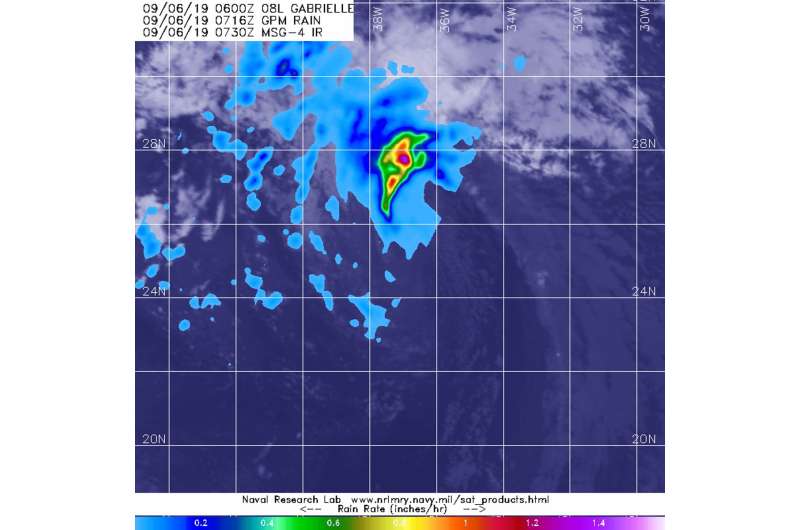NASA sees gabrielle go 'post-tropical...' for now

The Global Precipitation Measurement mission or GPM core satellite passed over the Eastern Atlantic Ocean and observed that Tropical Storm Gabrielle had become post-tropical. GPM also gathered data on rainfall rates occurring in transformed and elongated storm.
NOAA's National Hurricane Center (NHC) said at 5 a.m. EDT on Sept. 6 that Gabrielle has become a post-tropical cyclone over the eastern Atlantic, because "Poorly defined Gabrielle has not produced any organized deep convection (strong thunderstorms) since Thursday morning." However, regeneration into a tropical storm is expected to occur over the weekend.
A Post-Tropical Storm is a generic term for a former tropical cyclone that no longer possesses sufficient tropical characteristics to be considered a tropical cyclone. Former tropical cyclones that have become fully extratropical, subtropical, or remnant lows, are three classes of post-tropical cyclones. In any case, they no longer possesses sufficient tropical characteristics to be considered a tropical cyclone. However, post-tropical cyclones can continue carrying heavy rains and high winds.
The GPM satellite passed over Gabrielle on Sept. 6 at 3:30 a.m. EDT (0730 UTC). GPM found the heaviest rainfall in nearly 200 miles north of the elongated center, where it was falling at a rate of over 36 mm (about 1.4 inch) per hour. Areas of rainfall of about 25 mm (1 inch per hour) surrounded those stronger storms. GPM is a joint mission between NASA and the Japan Aerospace Exploration Agency, JAXA.
At 5 a.m. EDT (0900 UTC), NHC reported the center of Post-Tropical Cyclone Gabrielle was located near latitude 25.5 degrees north and longitude 37.6 degrees west. That is about 1,095 miles (1,760 km) northwest of the Cabo Verde Islands. The post-tropical cyclone is moving toward the northwest near 12 mph (19 kph). A turn to the west-northwest with a slight increase in forward speed is expected over the next couple of days. A decrease in forward speed and a turn to the north are forecast to occur by Sunday morning. Maximum sustained winds are near 40 mph (65 kph) with higher gusts.
Gabrielle is expected to weaken into a post-tropical remnant low by tonight. Thereafter, slow strengthening is expected to occur over the weekend, and the remnants of Gabrielle is forecast to regenerate into a tropical cyclone at that time.
Provided by NASA's Goddard Space Flight Center




















